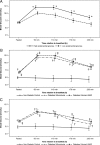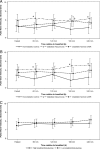Influence of Postprandial Hyperglycemic Conditions on Arterial Stiffness in Patients With Type 2 Diabetes
- PMID: 26731258
- PMCID: PMC4803174
- DOI: 10.1210/jc.2015-3635
Influence of Postprandial Hyperglycemic Conditions on Arterial Stiffness in Patients With Type 2 Diabetes
Abstract
Context: Patients with type 2 diabetes (T2D) are at an increased risk of cardiovascular disease.
Objective: The objective of the study was to determine whether postprandial hyperglycemia affects arterial function in T2D.
Design: A single-center, open-label study of three groups of men were studied: 1) T2D patients with albuminuria (n = 22), 2) T2D patients without albuminuria (n = 24), and 3) nondiabetic controls (n = 25). Patients were randomized to a two-period crossover study schedule, ingesting breakfast, with or without insulin lispro (to induce low or high postprandial glycemia).
Main outcome measures: Arterial stiffness was assessed by calculating pulse wave velocity (PWV) and augmentation index using applanation tonometry, and endothelial dysfunction was assessed using peripheral arterial tonometry, 30 minutes before breakfast and up to 240 minutes after breakfast.
Results: At baseline, arterial stiffness was increased in patients. When adjusted for age and body mass index, in a combined group of patients with and without albuminuria, brachial PWV was higher during low (P = .032) and high (P = .038) postprandial glycemia vs controls. These differences were driven by the albuminuria group vs controls during low (P = .014) and high (P = .018) postprandial glycemia. No differences were observed in aortic PWV, augmentation index, or peripheral arterial tonometry ratio between patients and controls. Endothelin-1 and IL-6 were higher, and superoxide dismutase was lower, during postprandial hyperglycemia in T2D patients vs controls.
Conclusions: In patients with T2D and albuminuria, brachial PWV was higher under postprandial hyperglycemic conditions, relative to controls. These data suggest that hyperglycemia induces an increase in stiffness of intermediate-sized arteries. We found no changes in other parts of the arterial bed.
Trial registration: ClinicalTrials.gov NCT01159938.
Figures



References
-
- Laurent S, Boutouyrie P, Asmar R, Gautier I, Laloux B, Guize L, Ducimetiere P, Benetos A. Aortic stiffness is an independent predictor of all-cause and cardiovascular mortality in hypertensive patients. Hypertension. 2001;37:1236–1241. - PubMed
-
- Blacher J, Asmar R, Djane S, London GM, Safar ME. Aortic pulse wave velocity as a marker of cardiovascular risk in hypertensive patients. Hypertension. 1999;33:1111–1117. - PubMed
-
- Stehouwer CDA, Henry RMA, Ferreira I. Arterial stiffness in diabetes and the metabolic syndrome: a pathway to cardiovascular disease. Diabetologia. 2008;51:527–539. - PubMed
-
- Wilkinson IB, Franklin SS, Cockcroft JR. Nitric oxide and the regulation of large artery stiffness: from physiology to pharmacology. Hypertension. 2004;44:112–116. - PubMed
Publication types
MeSH terms
Substances
Associated data
LinkOut - more resources
Full Text Sources
Other Literature Sources
Medical

